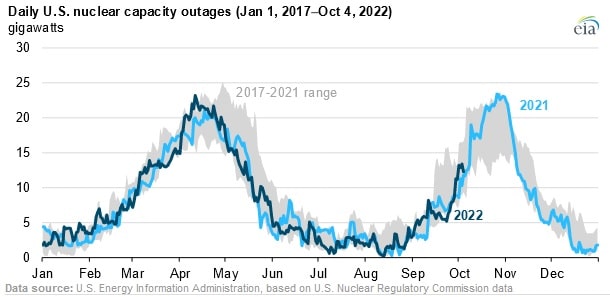U.S. Daily Nuclear Capacity Outages in Summer 2022 Fell by 19 Percent: EIA

Daily nuclear capacity outages in the U.S. dropped by 19 percent this summer, from June through August, compared to the same period last year, according to the U.S. Energy Information Administration. Outages averaged 2.5 gigawatts, down from the 3.1-gigawatt average in summer 2021. The decline is largely due to fewer unplanned outages, which fell by nearly half compared to last year.
Twenty-four unplanned nuclear outages have occurred this year as of Oct. 4, 2022 compared with 51 in 2021. The average planned refueling outage in 2022 as of Oct. 4 lasted 38 days, slightly higher than the average of 30 days last year. Summer outages this year were lowest in mid-August, averaging one gigawatt, and highest in June, reaching a 3.8-gigawatt average.
The scope of planned outages generally includes preventive maintenance of the nuclear power plant and refueling of the reactor. Generally, U.S. nuclear power plants are refueled during the spring and fall, when the electricity demand is low, and a typical refueling cycle occurs every 18 to 24 months. During this outage, plant downtimes are optimized through other scheduled activities like facility upgradation, repair, and other maintenance work. In 2022, an outage due to refueling the reactor lasted more than 30 days, which was caused by the shutdown of the Watts Bar and Fermi nuclear power plants.
Unplanned outages generally include a forced outage shutdown. This can be due to internal or external circumstances and early retirement. Internal factors resulting in unplanned outages include equipment failure or operational error. External circumstances can be due to bad weather.
Early retirements can be classified under unplanned outages. The Palisades Nuclear Plant in Michigan, for example, was completely shut down in May 2022, despite the fact that the license to operate the plant was valid until 2031. Due to this, the summer nuclear generation capacity of 770 gigawatts was affected.
EnerKnol Pulses like this one are powered by the EnerKnol Platform—the first comprehensive database for real-time energy policy tracking. Sign up for a free trial below for access to key regulatory data and deep industry insights across the energy spectrum.
ACCESS FREE TRIAL